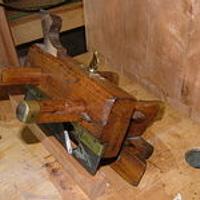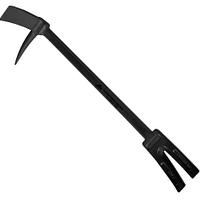Share your craft projects
Make new craft buddies
Ask craft questions
Blog your craft journey

Dave Polaschek
2150 posts
and
43 followers
in about 3 years
in about 3 years
More from Dave Polaschek
Juniper and purple resin bowl #4: Cleanup and finishing prep
Juniper and purple resin bowl #2: Finish turning the exterior, filling fine cracks
Juniper and purple resin bowl #1: Start, rough turning, epoxy, and hollowing
Building a cane #14: Joining the pieces
Building a cane #13: Finished the carving, finishing
Juniper and purple resin bowl #3: Final turning the inside, more patching
This is
part 3
in a
4 part
series:
Juniper and purple resin bowl
-
Finish turning the exterior, filling fine cracks
-
Final turning the inside, more patching
-
Cleanup and finishing prep
- Finish turning the exterior, filling fine cracks
- Final turning the inside, more patching
- Cleanup and finishing prep
This evening, I got a couple hours in the shop. Set up the laser-guided hollowing rig and took the bowl down to a little over a quarter inch. I had been aiming for ⅛ inch (3mm) but the wood just wasn’t solid enough, and I chickened out.

After hollowing, I could see that the big crack (the inside part of the bark inclusion, just hidden in the photo above) wasn’t completely filled on the inside, so I guess I was lucky I stopped hollowing when I did. When I was sawing off the tenon from the bottom, I heard a crack, but stopped and did some filling with cosmetic mica and CA glue, which solidified things a bit.
Of course, some CA glue got where it shouldn’t, so I needed to make a skinny, curved card-scraper to remove the excess glue from inside the bowl. And if you look at the photo below, you’ll see where some gray sanding dust got pushed into the grain. I’ll be cleaning that up with the scraper too. The little rotary bowl sanders will sometimes do that, especially with epoxy dust. You can see it downstream of the epoxy in the photo above, too.

I think I’ll also inspect all the cracks that are now visible from the inside of the bowl, and make sure they’re all filled if possible. It’s going to be fussy work, but that’s ok. There’s also a tiny divot in the epoxy visible in the second photo. I’m going to need to decide if I’m going to fix that, and how. Maybe a little file work will be the ticket. Or maybe I’ll just leave it.
Once I was done with the patching and some sanding, I finished sawing off the tenon and used a #3-25mm in-cannel gouge to clean that up. Of course the gouge was new from Ashley Iles, and I hadn’t done the initial sharpening on it, so that took some time too. I was kind of shocked at just how dull it was from the factory. Tsk.
Oh, the sides, as I said, are a bit over ¼ inch thick. The bottom is about ½ inch. Hopefully I can get most of the hand-sanding done tomorrow, and start finishing. I would’ve rather finished it on the lathe, but maybe I can still do that with a jam-chuck.
May you have the day you deserve!
9 Comments
lookin real cool dave. i dont blame you for backin off on the thickness with all the fill, id do the same !
working with my hands is a joy,it gives me a sense of fulfillment,somthing so many seek and so few find.-SAM MALOOF.
Looks good, hope it finishes up well. Be interesting.
Ron
That's a very cool bowl Dave, quite beautiful with the semi-clear blue epoxy sections.
That laser guided hollowing tool is fascinating to say the least. I think you finished at the right time though, I think an eighth of an inch might be too fragile.
That laser guided hollowing tool is fascinating to say the least. I think you finished at the right time though, I think an eighth of an inch might be too fragile.
Awesome!
Ryan/// ~sigh~ I blew up another bowl. Moke told me "I made the inside bigger than the outside".
Yeah. As I was turning and got down to a quarter, I could hear the bowl flexing, but it wasn’t a “singing” sound, it was more flat, which convinced me there was a crack I wasn’t seeing. Sure enough…
Anyway, this bowl will never “ring like a bell,” like I had hoped. Too many cracks and too much resin.
Tom, the laser-guided tool is pretty handy if you want to go thinner than a quarter. Thicker than that, I can get by with a caliper or my fingers judging the thickness, but under a quarter, almost every bowl I’ve made will start flexing as the tool touches it, and that’s where I find the laser super-handy. Also for going across the bottom of the bowl, I can more reliably get a flat and level bottom using the laser.
Anyway, this bowl will never “ring like a bell,” like I had hoped. Too many cracks and too much resin.
Tom, the laser-guided tool is pretty handy if you want to go thinner than a quarter. Thicker than that, I can get by with a caliper or my fingers judging the thickness, but under a quarter, almost every bowl I’ve made will start flexing as the tool touches it, and that’s where I find the laser super-handy. Also for going across the bottom of the bowl, I can more reliably get a flat and level bottom using the laser.
May you have the day you deserve!
Nice color and wood combo with the wood defects adding all that character!
I think it'll age well and mellow when the wood gets some oxidation. I think you were brave to go down to even 1/4, can't imagine the disappointment if you blew it up after all this work.
Has anyone tried stabilizing a bowl at this stage (Cactus Juice + vacuum pot)?
I think it'll age well and mellow when the wood gets some oxidation. I think you were brave to go down to even 1/4, can't imagine the disappointment if you blew it up after all this work.
Has anyone tried stabilizing a bowl at this stage (Cactus Juice + vacuum pot)?
Thanks, Splint. Yeah, the whiter wood will turn yellow. And there is a metric shit-ton of character.
Thanks, but I generally feel good turning down to a quarter. It’s beyond that where I get really worried about blowing things up. But I will note that I was using carbide tools towards the end, and angling them for as much negative rake as I could get.
I haven’t tried stabilizing something at this stage because it would be a huge waste as the cactus juice ran out of the piece as you baked it to set the juice. Even wrapping it in tinfoil it would be hard not to end up with the juice puddling inside the bowl, even filling the space with something impermeable.
Thanks, but I generally feel good turning down to a quarter. It’s beyond that where I get really worried about blowing things up. But I will note that I was using carbide tools towards the end, and angling them for as much negative rake as I could get.
I haven’t tried stabilizing something at this stage because it would be a huge waste as the cactus juice ran out of the piece as you baked it to set the juice. Even wrapping it in tinfoil it would be hard not to end up with the juice puddling inside the bowl, even filling the space with something impermeable.
May you have the day you deserve!
I've always let the parts drip-dry and after finding out about the "puddling" you mentioned the hard way, I inverted the stuff with shallows (wrapped in foil).
outer layer was always frothy after baking, but the vacuum potting really drove the Juice in deep.
I know that stuff has a cure temp of 200+ F so there is that affecting the resin too!
outer layer was always frothy after baking, but the vacuum potting really drove the Juice in deep.
I know that stuff has a cure temp of 200+ F so there is that affecting the resin too!
Yeah. I think if I were to do it that way, I would leave it at least a half-inch thick, and try to figure a way to minimize the leakage.
When I accidentally “glued” two knife scales together stabilizing them years ago, I found that baked cactus juice with no wood to hold it together is pretty brittle, and a cold chisel placed between the two pieces and given a sharp rap broken them apart with minimal collateral damage. But Curtis has reformulated Cactus Juice since then, maybe twice, so maybe it doesn’t behave the same? A guy could always call him and ask. I found him friendly and helpful the couple times I had questions.
When I accidentally “glued” two knife scales together stabilizing them years ago, I found that baked cactus juice with no wood to hold it together is pretty brittle, and a cold chisel placed between the two pieces and given a sharp rap broken them apart with minimal collateral damage. But Curtis has reformulated Cactus Juice since then, maybe twice, so maybe it doesn’t behave the same? A guy could always call him and ask. I found him friendly and helpful the couple times I had questions.
May you have the day you deserve!
More from Dave Polaschek
Juniper and purple resin bowl #4: Cleanup and finishing prep
Juniper and purple resin bowl #2: Finish turning the exterior, filling fine cracks
Juniper and purple resin bowl #1: Start, rough turning, epoxy, and hollowing
Building a cane #14: Joining the pieces
Building a cane #13: Finished the carving, finishing













